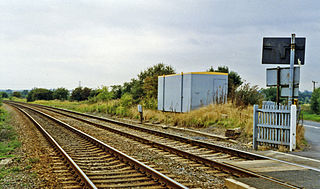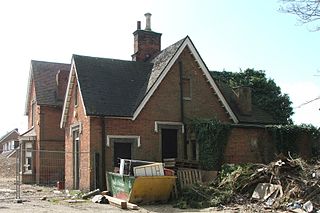The Edinburgh–Bathgate line is a railway line in East Central Scotland. It is also known as the Bathgate branch and was originally operated by the Edinburgh and Bathgate Railway. Except for the short section at the original Bathgate terminus, the main line is still in use, with a frequent passenger train service operated by ScotRail.

Alness railway station is a railway station on the Far North Line, serving the town of Alness, on the Cromarty Firth, in the Highland council area of Scotland. The station is 28 miles 70 chains (46.5 km) from Inverness, between Dingwall and Invergordon. ScotRail, who manage the station, operate all services.

Newtonmore railway station serves the village of Newtonmore, Highland, Scotland. The station is managed by ScotRail and is on the Highland Main Line. The station is 68 miles 62 chains (110.7 km) from Perth, between Dalwhinnie and Kingussie, and has a single platform which is long enough for a ten-coach train. It is currently the only station on the Highland Main Line to have one platform, although the former second platform can still be seen adjacent to the first platform.

The Stirling and Dunfermline Railway was a railway in Scotland connecting Stirling and Dunfermline. It was planned by the Edinburgh and Glasgow Railway to get access to the mineral deposits on the line of route, but also as a tactical measure to keep the rival Caledonian Railway out of Fife.
Ravenstonedale railway station was situated on the South Durham & Lancashire Union Railway (SD&LUR) between Tebay and Kirkby Stephen East. It served the villages of Ravenstonedale and Newbiggin-on-Lune.

Park Bridge Railway Station was a railway station on the Oldham, Ashton-under-Lyne and Guide Bridge Junction Railway (OA&GB) that served the village of Park Bridge, in the Medlock Valley near Ashton-under-Lyne's border with Oldham. It was sometimes known as Parkbridge, and one photograph of the station shows the station name board with the name as one word and immediately adjacent the signal box with it shown as two. The station opened on 26 August 1861 when the line opened.
For other stations named Ashton, see Ashton railway station (disambiguation)
The Strathspey Railway was a railway company in Scotland that ran from Dufftown to Boat of Garten. It was proposed locally but supported by the larger Great North of Scotland Railway (GNoSR), which wanted to use it as an outlet towards Perth. The GNoSR had to provide much of the funding, and the value of traffic proved to be illusory. The line opened in 1863 to Abernethy, but for the time being was unable to make the desired connection to the southward main line. Although later some through goods traffic developed, the route never achieved its intended purpose.

Stockport Portwood railway station was a railway station in Stockport, England on the Stockport and Woodley Junction Railway
The Glasgow and Milngavie Junction Railway was a short locally promoted branch line built to connect the industrial town of Milngavie with the main line railway network, near Glasgow, Scotland. It opened in 1863.

The Leaderfoot Viaduct, also known as the Drygrange Viaduct, is a railway viaduct over the River Tweed near Melrose in the Scottish Borders.

Asfordby railway station was a station serving the villages of Asfordby and Kirby Bellars in Leicestershire. The station was situated at a level crossing on the road between the two villages. It opened in 1846 and was originally named Kirby, but had been renamed Asfordby by 1863. It closed to passengers in 1951 but remained in use for goods until 1964.
The Duns Branch and the Berwickshire Railway together formed a through railway route from Reston, near Berwick-upon-Tweed, to St Boswells in the Scottish Borders. The line was promoted in two stages. The first was from Reston on the Edinburgh to Berwick main line to Duns ; it opened by the North British Railway in 1849.

The Buntingford branch line in Hertfordshire, England, connected Buntingford to the railway network at St Margarets. It was promoted locally and opened in 1863 after overspending its available capital. The line was completed with the assistance of the neighbouring Great Eastern Railway. Residential travel and goods services became significant at the end of the 19th century. The area served by the line was predominantly agricultural, and after 1948 usage did not keep pace with rising costs. When the Hertford East branch was electrified, Buntingford branch trains were reduced in frequency with through trains to London withdrawn. The line was recommended for closure in the Beeching Report, and the passenger service was withdrawn in 1964; goods services closed in 1965.

The Cirencester branch line was a five-mile-long single-track branch railway line in Gloucestershire, England that connected Cirencester to the main line at Kemble. It was opened by the Cheltenham and Great Western Union Railway in 1841. The main line was extended from Kemble to a junction near Gloucester in 1845, by the GWR which had taken over the C&GWUR. The branch supported a busy passenger and goods business, but these declined in the 1930s, and closure was threatened in the 1950s. To reduce costs and maintain the viability of the line, lightweight four-wheel diesel railbuses were introduced, and they proved popular. Nevertheless, the line's decline was inexorable, passenger service closed in 1964 and the goods service ending the following year.
The Dumfries, Lochmaben and Lockerbie Railway was a railway in Dumfriesshire, Scotland. It connected Dumfries with Lockerbie via Lochmaben. Promoted independently, it was absorbed by the Caledonian Railway to give access to Dumfriesshire and later to Portpatrick for the Irish ferry service. It opened in 1863, closed to ordinary passenger services in 1952, and closed completely in 1966.
The Esk Valley Railway was a short branch line built to serve industry in the valley of the River North Esk, south of Edinburgh in Scotland. The terminus was Polton. The line opened on 15 April 1867

Portgordon railway station was a railway station in Portgordon in Moray, Scotland. The railway station was opened by the Great North of Scotland Railway (GNoSR) on its Moray Firth coast line in 1886, served by Aberdeen to Elgin trains. In 1923 the GNoSR became part of the London and North Eastern Railway (LNER) and at nationalisation in 1948 became part of British Railways. The station was named Port Gordon railway station until 1938 when it was renamed 'Portgordon' by the LNER.

Greenlaw railway station served the town of Greenlaw, Scottish Borders, Scotland from 1863 to 1948 on the Berwickshire Railway.
Marchmont railway station served the estate of Marchmont, Scottish Borders, Scotland from 1863 to 1948 on the North British Railway.











